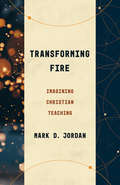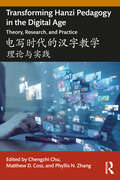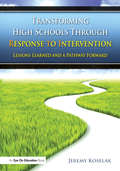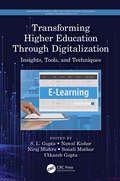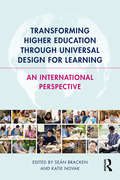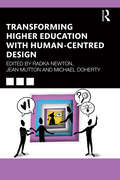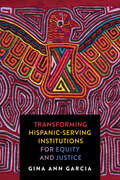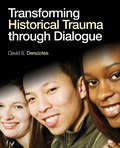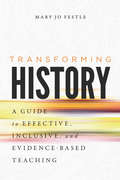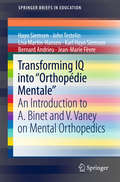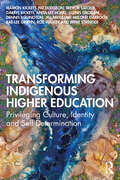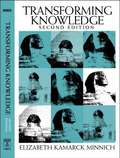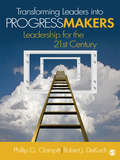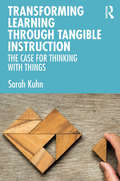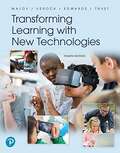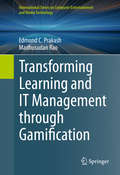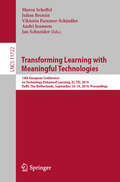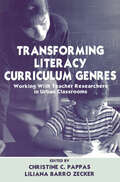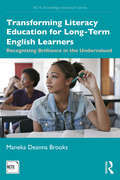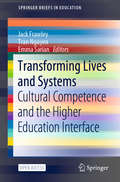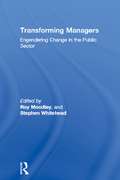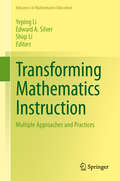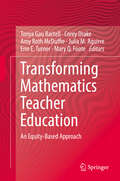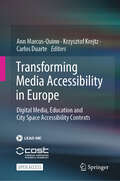- Table View
- List View
Transforming Fire: Imagining Christian Teaching (Theological Education between the Times)
by Mark D. Jordan&“We don&’t need books about teaching so much as books that teach.&” Considering Jesus himself taught in a variety of ways—parable, discussion, miracle performance, ritual observance—it seems that there can be no single, definitive, Christian method of teaching. How then should Christian teaching happen, especially in this time of significant change to theological education as an institution? Mark Jordan addresses this question by first allowing various depictions and instances of Christian teaching from literature to speak for themselves before meditating on what these illustrative examples might mean for Christian pedagogy. Each textual scene he shares is juxtaposed with a contrasting scene to capture the pluralistic possibilities in the art of teaching a faith that is so often rooted in paradox. He exemplifies forms of teaching that operate beyond the boundaries of scholarly books and discursive lectures to disrupt the normative Western academic approach of treating theology as a body of knowledge to be transmitted merely through language. Transforming Fire consults writers ranging from Gregory of Nyssa to C. S. Lewis, and from John Bunyan to Octavia Butler, cutting across historical distance and boundaries of identity. Rather than offering solutions or systems, Jordan seeks in these texts new shelters for theological education where powerful teaching can happen and—even as traditional institutions shrink or vanish—the hearts of students can catch fire once again.
Transforming Hanzi Pedagogy in the Digital Age: 电写时代的汉字教学: 理论与实践
by Chengzhi Chu Matthew D. Coss Phyllis N. ZhangTransforming Hanzi Pedagogy in the Digital Age 电写时代的汉字教学 brings together expert researchers and practitioners to offer a coherent theoretical, empirical, pedagogical, and experiential justification for a shift in pedagogical focus from handwriting to e-writing in L2 Chinese pedagogy.This volume argues for a pedagogy based on the 21st century communicative needs of L2 Chinese users, grounded in empirical research as well as practical and lived experiences. The authors propose an “e-writing as primary” (电写为主,手写为辅) framework for L2 Chinese instruction in the 21st century, a transformational proposal which will fundamentally shift the pedagogical focus of L2 Chinese instruction globally towards more learner-centered, research-informed practice. This volume includes three theoretical foundation chapters, four empirical studies, three descriptions of program-level implementation, and ten expert L2 Chinese user vignettes, which, taken together, offer a thorough introduction to e-writing for the future of L2 Chinese teaching and learning.This book will be informative for Chinese language instructors, researchers, program directors, materials developers, and advanced graduate students in both CFL and CSL contexts worldwide.
Transforming High Schools Through RTI: Lessons Learned and a Pathway Forward
by Jeremy KoselakSimplify your approach to implementing Response-to-Intervention (RTI) and make strides toward improved achievement in your high school. In this book, experienced educator Jeremy Koselak shows high school leaders how to attain measurable results through a framework of tiered, dynamic intervention strategies known as RTI. With an awareness of the challenges unique to implementing RTI in high schools, the author explains many of the best policies for continuous improvement. Strategies highlight essential steps for successfully implementing RTI and present a pathway for avoiding common pitfalls. Unique features of this book include: An updated synthesis of high school level RTI recommendations derived from an assortment of research. A frank discussion on the practical concerns and limitations associated with implementing RTI in high schools An illustration of how to embed data-based decision-making into a school's culture Templates and figures demonstrating high school samples Reflections and case studies for actual high schools And more!
Transforming Higher Education Through Digitalization: Insights, Tools, and Techniques (Demystifying Technologies for Computational Excellence)
by S. L. Gupta Nawal Kishor Niraj Mishra Sonali Mathur Utkarsh GuptaHigher education is dynamic, constantly adapting to meet the requirements of students and industry. Transforming Higher Education Through Digitalization: Insights, Tools, and Techniques provides insights from experienced academicians on the digitalization of education and its appropriateness for enhancing the quality of teaching in institutions of higher education. The book also provides insights on technologies used in digital education, the competencies and skills required by teachers and students, managing quality of education through online modes, MOOCs (Massive, Open, Online Courses), and methods to support teachers and instructors in online education. The book also enables teachers and instructors to help students develop the knowledge and skills they need in a digital age and enable them to build collaborative learning that will bring them success. Written for educators, students, and policy makers of higher education, this book demonstrates how to transform traditional education to digital education and to continue their activities without the requirement of students and teachers meeting each other on campus.
Transforming Higher Education Through Universal Design for Learning: An International Perspective
by Katie Novak Seán BrackenProviding insight into the background, theory and practical applications of Universal Design for Learning (UDL), Transforming Higher Education through Universal Design for Learning: An International Perspective examines and shares best practice in UDL implementation worldwide to provide strategies for strengthening student accessibility, engagement and learning outcomes through the development of flexible learning environments. Drawing upon insightful, research-based contributions from educators and student service specialists in Australia, Belgium, Brazil, Canada, Ireland, Israel, Norway, South Africa, Spain, the UK and all across the USA, this book: considers diversity in the form of disability, minority ethnic groups, gender identities, first generation university students and varying socio-economic backgrounds; brings together key thinkers and actors in the field of UDL and expertly maps its practices to the higher educational domain; explores the multiple means of representation, expression and engagement that combine to create a successful UDL framework. Each chapter not only provides a different perspective of how UDL has helped meet the needs of all students to ensure that education is accessible, culturally responsive and socially just, but also considers how this can then be implemented into higher education environments the world over. This book is a crucial read for those who want to make a positive difference in higher education provision and outcomes.
Transforming Higher Education With Human-Centred Design
by Radka NewtonEncouraging a collaborative and thoughtful approach to the wicked problems facing higher education (HE), this book is a showcase of pioneering educators who believe that well-designed education is good for everyone - learners, teachers, education administrators, the learning organisation and the world.Through case studies, thought pieces and practical advice, this book takes a fresh look at the application of Design Thinking and Service Design in a variety of university contexts. Human-centred design perspectives show up the fact that decades of rhetoric about student-centred learning have often left the student still effectively marginalised from change processes. The reader will encounter ample tools and techniques of design and co-creation that can enhance the student experience, from applicant to alumnus. More importantly, the book sets out, in actionable ways, how we can make our universities more effective at supporting students for success, and to become places where people are more empowered to make those changes. University academics, learning support staff, managers and professional staff, as well as HE policy makers and professional bodies, will appreciate this clear and practical guide to exploring service design in the new context of education.
Transforming Higher Education in Asia and Africa: Strategic Planning and Policy (SUNY series in Global Issues in Higher Education)
by Fred M. HaywardDrawing on over fifty years of on-the-ground experience, Fred M. Hayward's Transforming Higher Education in Asia and Africa analyzes change processes in higher education in eight Asian and African countries. The twelve cases range from the push to upgrade and transform higher education in Afghanistan in the midst of a war, to the successful struggle against apartheid in South African institutions, as well as thwarted efforts in Sierra Leone and Madagascar. Providing both practical lessons learned and hope for communities globally, Hayward demonstrates that higher education change and even transformation, which is more fundamental and structural, can occur even in the most difficult environments. Successful transformation requires well-crafted strategic and budget plans with careful implementation, monitoring, and effective leadership at multiple levels. Yet also critical are a commitment to human development, a desire for freedom and belief in democracy, and recognition that high-quality higher education is essential to national development.
Transforming Hispanic-Serving Institutions for Equity and Justice
by Gina Ann GarciaThe framework to help Hispanic-Serving Institutions transform into spaces of liberation that promote racial equity and social justice.Beyond having over a quarter of their undergraduate students be Hispanic, what makes Hispanic-Serving Institutions (HSIs) uniquely Latinx? And how can university leaders, faculty, and staff transform these institutions into spaces that promote racial equity, social justice, and collective liberation?In Transforming Hispanic-Serving Institutions for Equity and Justice, Gina Ann Garcia argues that in order to serve Latinx students and other students of color, these institutions must acknowledge how whiteness operates across the organization, from the ways that it is governed and how decisions are made to how education and knowledge are delivered. Diversity alone is insufficient for achieving a dynamic learning environment within higher education institutions. Garcia's framework for transforming HSIs into truly Latinx institutions is grounded in critical theories, yet it advances new ways of thinking about how to organize colleges and universities that are actively serving students of color, low-income students, and students from other minoritized backgrounds. This framework connects multiple important dimensions, including mission, identity, strategic purpose, membership, curriculum, student services, physical infrastructure, governance, leadership, external partnerships, and external influences. Drawing on over 25 years of HSI research, Garcia offers unique solutions for colleges and universities that want to better serve their students. With over 550 colleges and universities already eligible for the HSI designation, this book is a must-read for everyone in higher education.
Transforming Historical Trauma through Dialogue
by David S. DerezotesTransforming Historical Trauma, by David S. Derezotes, helps readers understand the causes and treatment of historical trauma at an individual, group, and community level and demonstrates how a participatory, strengths-based approach can work effectively in its treatment. The first to offer a combination of theory, literature review, and practice knowledge on dialogue, this book begins with a definition of historical trauma and transformation, includes the dialogue necessary to aid in transformation (such as self-care, self-awareness and professional self- development). The author proposes six key models of dialogue practice—psychodynamic, cognitive behavioral, experiential, transpersonal, biological, and ecological—and shows how these models can be used to help transform sociohistorical trauma in clients. He then applies these six dialogue models to five common practice settings, including work with community divides, social justice work, peace and conflict work, dialogues with populations across the lifespan, and community therapy.
Transforming History: A Guide to Effective, Inclusive, and Evidence-Based Teaching
by Mary Jo FestleTeaching history well is not just a matter of knowing history—it is a set of skills that can be developed and honed through practice. In this theoretically informed but eminently practical volume, Mary Jo Festle examines the recent explosion of research on the teaching and learning of history. Illuminated by her own work, Festle applies the concept of "backward design" as an organizing framework to the history classroom. She provides concrete strategies for setting up an environment that is inclusive and welcoming but still challenging and engaging. Instructors will improve their own conceptual understandings of teaching and learning issues, as well as receive guidance on designing courses and implementing pedagogies consistent with what research tells us about how students learn. The book offers practical illustrations of assignments, goals, questions, grading rubrics, unit plans, and formats for peer observation that are adaptable for courses on any subject and of any size. Transforming History is a critical guide for higher and secondary education faculty—neophytes and longtime professionals alike—working to improve student learning.
Transforming IQ into “Orthopédie Mentale“: An Introduction to A. Binet and V. Vaney on Mental Orthopedics (SpringerBriefs in Education)
by Hayo Siemsen John Testelin Lisa Martin-Hansen Karl Hayo Siemsen Bernard Andrieu Jean-Marie FèvreThis volume discusses Alfred Binet’s works on pedagogy based on his “Orthopédie Mentale”. Binet had empirically found that his idea of a test of general intelligence could be replaced by a test on “problem areas”. These problem areas were then to be specifically addressed and improved within a relatively short time. As a result, students dramatically improved in their IQ test results. Binet died before he could publish the results. Fortunately, the rector of the school, Victor Vaney, published the results of Binet’s experiments in his school. This volume provides the first English translation of Vaney's publication as well as an introduction to Binet's mostly forgotten late work.
Transforming Indigenous Higher Education: Privileging Culture, Identity and Self-Determination
by Ernie Stringer Pat Dudgeon Marion Kickett Trevor Satour Darryl Kickett Anita Lee Hong Glenis Grogan Dennis Eggington Jill Abdullah Melony Darroch Rae-Lee Griffin Roz WalkerAn engaging guide for future best-practice, this book provides an illuminating account of how the innovative programs of education and research at one Centre for Aboriginal Studies made a demonstrably positive difference in the lives of Indigenous students. Written by the experts involved, the book provides detailed descriptions of these ground-breaking education and research programs that saw an increase in the number of Indigenous graduates emerging from the Centre for Aboriginal Studies at Curtin University. Each chapter documents a different stage in the development and delivery of these programs and demonstrates how innovative and culturally appropriate principles of teaching, learning and organizational processes empowered participants to make a real difference in the lives of their families and communities. The book also addresses the challenges faced by such programs and the counterproductive pressures of market-based economic policies, highlighting the need to create an environment attuned to Aboriginal desires for social justice, self-management and self-determination. As a celebration of genuine success in higher education for Aboriginal and Torres Strait Islander students, and a guide on how to improve practice in the future, this book is an essential resource for all professionals and policy makers looking to make a real difference in the lives of Indigenous peoples.
Transforming Knowledge, Second Edition
by Minnich Elizabeth KamarckThis is a book about how we define knowledge and how we think about moral and political questions. It argues that the prevailing systems of knowledge, morality, and politics are rooted in views that are exclusionary and therefore legitimate injustice, patriarchy, and violence. That is, these views divide humans into different kinds along a hierarchy whose elite still defines the systems that shape our lives and misshape our thinking. Like the first edition of Transforming Knowledge, this substantially revised edition calls upon us to continue to liberate our minds and the systems we live within from concepts that rationalize inequality. It engages with the past fifteen years of feminist scholarship and developments in its allied fields (such as Cultural Studies, African American Studies, Queer Studies, and Disability Studies) to critique the deepest and most vicious of old prejudices. This new edition extends Minnich's arguments and connects them with the contemporary academy as well as recent instances of domination, genocide, and sexualized violence. * Updated to consider recent scholarship in Gender, Multicultural, Postcolonial, Disability, Native American, and Queer Studies, among other fields of study * Revised to include an extended analysis of the conceptual errors that legitimate domination, including the construction of kinds ("genders") of human beings * Revised to include new materials from a variety of cultures and times, and engages with today's contemporary debates about affirmative action, postmodernism, and religion
Transforming Leaders Into Progress Makers: Leadership for the 21st Century
by Phillip G. Clampitt Robert J. DeKochProgress: the focus of a new perspective on leadershipWeaving together original research, novel strategies and tactics, and stories of successful leaders, this book provides insight into how to become a progress-making leader. Written by an academic and a business executive, the book provides actionable ideas grounded in sound research and tested in real organizations. Find out more!1. Click on the Features/New to this Edition tab above for more information about the book.2. Visit the authors′ website for teaching and learning resources: 3. Watch the video! A video touching on some of the issues covered in the book is available on YouTube. This video is a great resource that can be used in the classroom to launch discussion about the nature of leadership.
Transforming Learning Through Tangible Instruction: The Case for Thinking With Things
by Sarah KuhnTransforming Learning Through Tangible Instruction offers a transformative, student-centered approach to higher education pedagogy that integrates embodied cognition into classroom practice. Evidence across disciplines makes clear that people learn with their bodies as well as their brains, but no previous book has provided evidence-based guidance for adopting and refining its practice in colleges and universities. Collecting findings from cognitive science, educational neuroscience, learning theories, and beyond, this volume’s unique approach—radical yet practical, effective yet low-cost—will have profound implications for higher education faculty and administrators engaged in teaching and learning. Seven concise chapters explore how physical objects, hands-on making, active construction, and other elements of body and environment can enhance comprehension, memory, and individual and collaborative learning.
Transforming Learning With New Technologies
by Sharon Edwards Robert Maloy Ruth-Ellen Verock Torrey TrustA guide to transforming classrooms into technology-infused places of learning Transforming Learning with New Technologies demonstrates the limitless ways teachers and students can use laptops, smartphones, coding, serious learning games, and many more new and emerging technologies to create highly interactive, inquiry-based teaching and learning experiences in K—12 schools. Focusing on the day-to-day realities of elementary and secondary schools, each chapter addresses the needs of future educators. <p><p>The authors provide thoughtful perspectives, instructional examples, descriptions of technology tools and apps, and technology-integrated lesson plans from across the curriculum and for all grade levels as starting points for new teachers to use in developing technology-based learning for students. <p><p>The 4th Edition has been substantially revised and updated, featuring chapters aligned to the newest ISTE standards and material on the latest highly interactive technologies and strategies for teaching and learning.
Transforming Learning and IT Management through Gamification
by Edmond C. Prakash Madhusudan RaoThis book explains how gamification, specifically enterprise gamification, can help mangers in multiple areas within an enterprise to improve attrition. Employee Engagement is an important component to foster employee relations with the organization. Gamification by its inherent design helps to increase engagement within an enterprise. Several successful case studies in Gamification are presented, which present new practical tips for Gamification for IT Management. By introducing general IT management concepts related to the specific environment managers work in, the authors then detail the benefits of introducing gamification in this very environment to resolve business issues. IT Managers, as well as HR professionals, Group Heads and Delivery Leaders will find this be a useful resource to understand how Gamification can improve their everyday work. The book can also be used as a reference for engaging learners and employees to improve their productivity in organizations.
Transforming Learning with Meaningful Technologies: 14th European Conference on Technology Enhanced Learning, EC-TEL 2019, Delft, The Netherlands, September 16–19, 2019, Proceedings (Lecture Notes in Computer Science #11722)
by Andri Ioannou Julien Broisin Viktoria Pammer-Schindler Maren Scheffel Jan SchneiderThis book constitutes the proceedings of the 14th European Conference on Technology Enhanced Learning, EC-TEL 2019, held in Delft, The Netherlands, in September 2019. The 41 research papers and 50 demo and poster papers presented in this volume were carefully reviewed and selected from 149 submissions. The contributions reflect the debate around the role of and challenges for cutting-edge 21st century meaningful technologies and advances such as artificial intelligence and robots, augmented reality and ubiquitous computing technologies and at the same time connecting them to different pedagogical approaches, types of learning settings, and application domains that can benefit from such technologies.
Transforming Literacy Curriculum Genres: Working With Teacher Researchers in Urban Classrooms
by Christine C. Pappas Liliana ZeckerIn this volume, university researchers and urban elementary teacher-researchers coauthor chapters on the teachers' year-long inquiries, on a range of literacy topics that they conducted as part of a collaborative school-university action research project. Central to this project was the teacher-researchers' attempts to transform their teaching practices to meet the needs of students from diverse ethnic and linguistic backgrounds, and their finding that their inquiry efforts resulted in developing more collaborative styles of teaching. Because the everyday interactions between teachers and students are realized by the social talk in the classroom, the university- and teacher-researchers analyzed classroom discourse to study and document the teachers' efforts to make changes in the locus of power in literacy teaching and learning. The chapters include many classroom discourse examples to illustrate the critical points or incidents of these teachers' inquiries. They show the successes and the struggles involved in shedding teacher-controlled patterns of talk. This book explores the process of urban teachers' journeys to create dialogically organized literacy instruction in particular literacy routines--called, in this book, curriculum genres. The book is organized in terms of these curriculum genres, such as writing curriculum genres, reading-aloud curriculum genres, drama curriculum genres, and so forth. Teacher inquiries were conducted in various elementary grade levels, from kindergarten through grade eight. Three occurred in bilingual classrooms and one in a special education classroom. The first and last chapters, written by the editors, provide the background, theoretical, and methodological underpinnings of the project.
Transforming Literacy Education for Long-Term English Learners: Recognizing Brilliance in the Undervalued (NCTE-Routledge Research Series)
by Maneka Deanna BrooksGrounded in research on bilingualism and adolescent literacy, this volume provides a much-needed insight into the day-to-day needs of students who are identified as long-term English language learners (LTELs). LTELs are adolescents who are primarily or solely educated in the U.S. and yet remain identified as "learning English" in secondary school. Challenging the deficit perspective that is often applied to their experiences of language learning, Brooks counters incorrect characterizations of LTELs and sheds light on students’ strengths to argue that effective literacy education requires looking beyond policy classifications that are often used to guide educational decisions for this population. By combining research, theory, and practice, this book offers a comprehensive analysis of literacy pedagogy to facilitate teacher learning and includes practical takeaways and implications for classroom practice and professional development. Offering a pathway for transforming literacy education for students identified as LTELs, chapters discuss reframing the education of LTELs, academic reading in the classroom, and the bilingualism of students who are labeled LTELs. Transforming Literacy Education for Long-Term English Learners is a much-needed resource for scholars, professors, researchers, and graduate students in language and literacy education, English education, and teacher education, and for those who are looking to create an inclusive and successful classroom environment for LTELs.
Transforming Lives and Systems: Cultural Competence and the Higher Education Interface (SpringerBriefs in Education)
by Jack Frawley Tran Nguyen Emma SarianThis open access book explores the transformative experiences of participants in the University of Sydney’s National Centre for Cultural Competence (NCCC) programs. The establishment of the NCCC was viewed as a critical point of departure for developing an institution-wide agenda of cultural competence. The NCCC’s work since its inception reflects efforts to lay important foundations for cultural change at the University. With the ultimate aim of establishing cultural competence as an agent for transformational change and social justice education, the NCCC has steadily expanded its research and teaching work both within and beyond the University of Sydney. Further, it has developed foundational resources to support and encourage University staff to integrate cultural competence philosophy and pedagogy in their curricula, teaching and research. This includes the ability to engage meaningfully with the cultures, histories and contemporary issues in Aboriginal and Torres Strait Islander communities. The NCCC programs have been designed to encourage participants to learn about who they are and how they can positively impact the transformational change the University has begun.The book presents participants’ reflections on their experiences at the organisational and personal level. Readers will gain insights into a range of topics including cultural competence, communities of practice, policy implementation, and transformative leadership at the interface between higher education and professional lives.
Transforming Managers: Engendering Change in the Public Sector (Gender, Change, And Society Ser.)
by Roy Moodley Stephen WhiteheadIn the 1990s, considerable changes in the political and social world have impacted on the character of both public and private organizations. At a time of increased uncertainty and insecurity in these organizations, new ways of managing and being managed have emerged. Recognising that organizational life is part reflective and determined by dominant social discourses, factors of gender will inevitably be central to the dynamics of organizational change. This book addresses theoretical ideas and mythologies in the examination of gendered organizations. The need to examine men in relation to family, law and society in general is growing, and this book extends this interrogation to work and organizational life. It will be of interest to students in management studies, public sector management and those involved in public policy making as well as students and academics within gender studies and sociology.
Transforming Mathematics Instruction
by Yeping Li Edward A. Silver Shiqi LiThis book surveys and examines different approaches and practices that contribute to the changes in mathematics instruction, including (1) innovative approaches that bring direct changes in classroom instructional practices, (2) curriculum reforms that introduce changes in content and requirements in classroom instruction, and (3) approaches in mathematics teacher education that aim to improve teachers' expertise and practices. It also surveys relevant theory and methodology development in studying and assessing mathematics instruction. Classroom instruction is commonly seen as one of the key factors contributing to students' learning of mathematics, but much remains to be understood about teachers' instructional practices that lead to the development and enactment of effective classroom instruction, and approaches and practices developed and used to transform classroom instruction in different education systems. Transforming Mathematics Instruction is organized to help readers learn not only from reading individual chapters, but also from reading across chapters and sections to explore broader themes, including: - Identifying what is important in mathematics for teaching and learning emphasized in different approaches; - Exploring how students' learning is considered and facilitated through different approaches and practices; - Understanding the nature of various approaches that are valued in different systems and cultural contexts; - Probing culturally valued approaches in identifying and evaluating effective instructional practices. The book brings new research and insights into multiple approaches and practices for transforming mathematics instruction to the international community of mathematics education, with 25 chapters and four section prefaces contributed by 56 scholars from 10 different education systems. This rich collection is indispensable reading for mathematics educators, researchers, teacher educators, curriculum developers, and graduate students interested in learning about different instructional practices, approaches for instructional transformation, and research in different education systems. It will help readers to reflect on approaches and practices that are useful for instructional changes in their own education systems, and also inspire them to identify and further explore new areas of research and program development in improving mathematics teaching and learning.
Transforming Mathematics Teacher Education: An Equity-Based Approach
by Erin E. Turner Tonya Gau Bartell Corey Drake Amy Roth McDuffie Julia M. Aguirre Mary Q. FooteThis book builds on the Teachers Empowered to Advance Change in Mathematics (TEACH Math) project, which was an initiative that sought to develop a new generation of preK-8 mathematics teachers to connect mathematics, children’s mathematical thinking, and community and family knowledge in mathematics instruction – or what we have come to call children’s multiple mathematical knowledge bases in mathematics instruction, with an explicit focus on equity. Much of the work involved in the TEACH Math project included the development of three instructional modules for preK-8 mathematics methods courses to support the project’s goals. These activities were used and refined over eight semesters, and in Fall 2014 shared at a dissemination conference with other mathematics teacher educators from a variety of universities across the United States. Chapter contributions represent diverse program and geographical contexts and teach prospective and practicing teachers from a variety of socioeconomic and ethnic backgrounds, in particular providing accounts of supports, challenges, and tensions in implementing equity-based mathematics teacher education. The chapters supply rich evidence and illustrative examples of how other mathematics teacher educators and professional developers might make the modules work for their unique practices, courses, workshops, and prospective teachers/teachers. It promises to be an important resource for offering guidance and examples to those working with prospective teachers of mathematics who want to create positive, culturally responsive, and equity-based mathematics experiences for our nation’s youth.
Transforming Media Accessibility in Europe: Digital Media, Education and City Space Accessibility Contexts
by Carlos Duarte Ann Marcus-Quinn Krzysztof KrejtzIn a rapidly evolving digital landscape, accessibility in media has emerged as a crucial frontier for inclusion, equality, and knowledge democracy. The present edited volume "Transforming Media Accessibility in Europe: Digital Media, Education and City Space Accessibility Contexts" is a comprehensive exploration of technological, societal, psychological, and legal aspects of media accessibility in Europe. It offers a comprehensive roadmap for navigating the multifaceted landscape of media accessibility. Through compelling experimental studies, case studies, and forward-looking insights, it elucidates the transformative potential of accessible media across diverse sectors, including education, culture, and smart cities. Crafted as a collaborative effort under the COST (European Cooperation in Science and Technology) LEAD-ME Action (CA19142), this book unites the expertise of researchers, educators, and practitioners. This is an open access publication.
